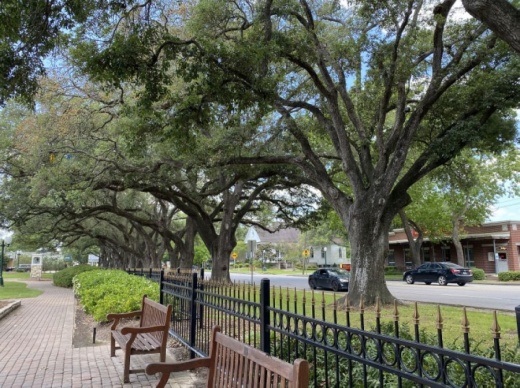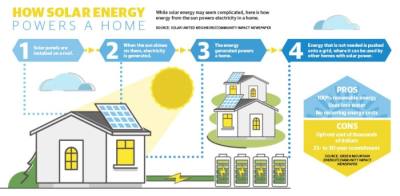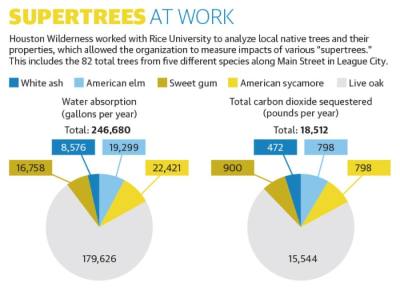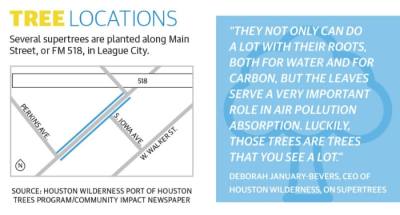The area is home to various industries, with petrochemical at the front and center: the Houston Ship Channel, which stretches from the Gulf of Mexico through Galveston Bay and up the San Jacinto River, is home to the country’s largest petrochemical complex.
As local towns and cities fill green spaces with residential and commercial structures, urban heat islands occur; these areas, in places like Clear Lake, experience higher temperatures due to infrastructure absorbing more heat than natural landscapes, according to the Environmental Protection Agency.
Environmental policy organization Houston Wilderness is fighting regional urban heat island effects one tree at a time through large-scale tree plantings, including some focused in southeast Houston, and Harris County Precinct 2 Commissioner Adrian Garcia is trying to grow the presence of solar energy in his precinct. At the University of Houston—Clear Lake, students can learn to balance profit and eco-friendliness through the master’s of business administration program.
Each industry has its own unique set of strengths and improvement points when it comes to sustainability, said Kathy Garland, senior lecturer in environmental management at UHCL. Decisions about sustainable business practices are therefore made individually, even if the issues at hand are prevalent worldwide.
“These industries, they’re always adapting,” Garland said. “The change is global, but all of the adjustments are local because it’s different in every place.”
The power of solar
Houston is considered the energy capital of the world, said Garcia and Hanna Mitchell, Texas program director at nonprofit Solar United Neighbors. However, both agreed the city’s history in oil and petroleum does not have to be at odds with solar energy.
“Houston prides itself on being the energy capital of the world, and I think that it can be an all-of-the-above energy capital of the world,” Mitchell said.
Since assuming his role, Garcia has ensured the county is making as strong of a statement with clean energy—solar energy in particular—as with any other kind of energy, he said. This means ensuring once solar energy becomes more popular, there will be jobs for the industry in Precinct 2.
“I want the jobs, skill sets, education, marketing and infrastructure all in place,” he said.
SUN, which was founded in 2011 and expanded to Texas in 2018, works to help interested residents in the same geographical region form a solar co-op, which brings down the cost of installing solar energy in their homes. Houston has been the most popular Texas market for using solar energy since 2018, Mitchell said.
“When people see it on their neighbor’s roof and they see it more normalized, we see more people thinking of getting solar themselves,” she said.
One SUN co-op of roughly 30 homes was created in September in the Pasadena, La Porte and League City area.
Sustainable buildings are also increasingly present in Clear Lake, Garland said. As part of their coursework, Garland’s students identify local Leadership in Energy and Environmental Design buildings; the national LEED system recognizes buildings using greener everyday components like energy-efficient lighting, solar panels and water conservation features.
In terms of commercial buildings, Garland said she and her students have found an increasing number of LEED buildings in Clear Lake.
“There are just more and more ... of these buildings in the Clear Lake area and all of Houston,” Garland said.
Urban heat islands
Clear Lake in particular, however, is faced with environmental challenges, given it has historically been home to many space industry-related facilities taking up much of the green spaces, Garland said. This results in the presence of the urban heat island effect, through which buildings and roads absorb and re-emit the sun’s heat more than natural landscapes.
Temperatures in areas affected by this phenomenon are 1-7 degrees Fahrenheit higher than temperatures in outlying areas, per the EPA.
Houston Wilderness advocates for the sustainable reuse of land throughout the Greater Houston region in accordance with the Gulf Houston Regional Conservation Plan. The plan’s third goal calls for an annual 4% increase in organic carbon absorption to benefit the air quality and help reduce urban heat spikes.
The nonprofit’s CEO Deborah January-Bevers pointed to Exploration Green in Clear Lake as an example of how to use available green space. Modeled after this project, three former golf courses throughout Houston are being converted to large stormwater detention basins with nature-based stabilization techniques installed, similar to Exploration Green’s conservancy, Houston Wilderness officials said.
“That’s a primary example of really all three of the goals of the regional conservation plan,” January-Bevers said of Exploration Green. “[This is] exactly what we need to be doing all over the region.”
Protecting and preserving land, restoring ecosystems and putting carbon back into the soil are three key areas affecting climate change in the region, January-Bevers said. The organization connects people to geographically defined ecosystems across eight Greater Houston counties—including Brazoria, Harris and Galveston—and engages them through large-scale initiatives, including tree plantings.
Houston Wilderness is coordinating several large-scale plantings over the next three months. A total of 1,500 trees were planted on a section of the Bayport Terminal near Pasadena and La Porte in late November. The organization’s goal is to plant another 1,000 in the same area before the end of 2020 and continue planting into winter 2021.
Tree plantings provide various benefits to an ecosystem, including increased air and water quality, carbon sequestration for large industrial and residential areas, and habitat creation for migratory species, Houston Wilderness officials said. To help mitigate the effects of urban heat islands, the nonprofit worked with Rice University experts to analyze Houston’s native trees and their properties then select about a dozen “supertrees” to be planted where they will have the most environmental impact.
“In our region, we recognize that trees are one of our biggest assets,” January-Bevers said. “Now, because of the science out there, we can take it a step further.”
Sustainable business
While planting supertrees and switching to renewable energy might be the right choices for some businesses or industries, others may focus on improving different practices. Businesses must closely examine their own ecological footprint and focus on balancing resources with costs through an incremental, gradual process prioritizing the most pressing issues, UHCL Associate Professor of Management Dina Abdelzaher said.
“One way to get everybody to listen is to talk about how this is going to help the bottom line,” she added.
Sustainability management students at UHCL—those Garland and Abdelzaher are teaching—keep this balance at the forefront of their studies. Coursework involves understanding the intersections of the economy, society and the environment and the part each plays as consumer goods are made, from the raw material stage to disposal, Abdelzaher said.
Greener business practices involve both the products a business sells and the environments where they are created. In buildings, actions such as switching to LED light bulbs, planting pollinator plants on the property or renovating the building ventilation system can all add up, Garland said.
The local petrochemical industry has made sustainable strides in the last two decades in particular by ensuring that plants make longer-lasting products correctly the first time, said Jim Griffin, senior vice president of San Jacinto College’s petrochemical training division and 30-year petrochemical manufacturing industry veteran. This involves ensuring top efficiency and safety practices.
“Plants that I worked in not that long ago had ten times as many safety injuries as they do today,” said Griffin, adding these plants also work every day on emissions reductions.
There are more than 120 petrochemical plants within 11 miles of the college’s LyondellBasell Center for Petrochemical, Energy, & Technology, and each of these plants has language about committing to sustainability in their mission statements. Plant managers meet with residents monthly to assess impacts on the area.
“Because they’re all about continuous improvement, they improve their efficiency,” Griffin said.•








